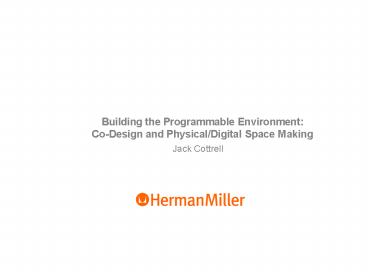Building the Programmable Environment: CoDesign and PhysicalDigital Space Making - PowerPoint PPT Presentation
1 / 52
Title:
Building the Programmable Environment: CoDesign and PhysicalDigital Space Making
Description:
In 1956 the Rosewood Plywood Eames Lounge designed by Charles and Ray Eames ... Pellicle; concept incorporates more patentable ideas than any other HMI research ... – PowerPoint PPT presentation
Number of Views:132
Avg rating:3.0/5.0
Title: Building the Programmable Environment: CoDesign and PhysicalDigital Space Making
1
Building the Programmable Environment Co-Design
and Physical/Digital Space Making
Jack Cottrell
2
In 1956 the Rosewood Plywood Eames Lounge
designed by Charles and Ray Eames was released.
Technology and design innovation layers of
wood veneer glued together and shaped under heat
pressure molding
3
In 1994 the Aeron Chair designed by Don Chadwick
and Bill Stumpft was released. Technology and
design innovation Ergonomics, stretch,
semitransparent flexible mesh called Pellicle
concept incorporates more patentable ideas than
any other HMI research program.
4
In 2008 the Embody Chair designed by Jeff Weber
was released. Technology and design innovation
biomechanics and ergonomics, back and Pixellated
support technology, 95 recyclable, employing 42
recycled content.
5
(No Transcript)
6
(No Transcript)
7
(No Transcript)
8
(No Transcript)
9
IF OUR HABITATS WERE PROGRAMMABLE, WHAT WOULD WE
ASK OF THEM?
10
If our economy runs on ideas how do we value an
idea?
a VISION?
Sustainability is never a static goal, it can
only be a process Bruce Sterling
Digital technology will become an intrinsic
component of the built environment, permeating
the building and transforming its architecture
from a design result to a design medium -
Always Building
11
PROGRAMMABLE ENVIRONMENT
The Programmable Environment is a design
construct. The fundamental performance attribute
of the Programmable Environment is its ability to
support change. When implemented, it works as a
physical and digital interface between the core
and shell of a building and the user.
12
It is possible for buildings to change more
gracefully. Materials are becoming less rigid.
Infrastructures more modular. Control has the
potential to be distributed.
13
The global construction industry employs more
than 100M people. 22 billion square feet of
commercial buildings in the U.S. account for 18
of energy consumption and 33 of all electricity.
14
Instead of designing a static product, spatial
technologies allow us to design an environmental
system that will continuously evolve in
interaction with its users.
15
Technology is everywhere in the built environment
temperature control, air quality monitoring,
security cameras, motion sensors, surface
systems, but there are limited standards for
interoperability.
16
Programmable Environment
PRINCIPLES OF DESIGN
Maximizing the capacity for adaptation The time
to effect change is ideally zeroPeople who
inhabit the space are its co-designers
Everything is recognized as both physical and
digital
hermanmiller.com/alwaysbuilding
17
DISTRIBUTED CONTROL PARADIGM
The more widely distributed the control, the more
adaptable the environment. The distribution of
control requires collaboration and negotiation of
constraints.
18
Distributed Control Paradigm enables
ADAPTATION
...from the owners point of view
19
Distributed Control Paradigm enables
Co-DESIGN
...from the users point of view
20
Static environment disconnect between
environment and user needs
Programmable Environment keeping pace with
changing needs
21
(No Transcript)
22
Modular building system infrastructure.
Organizes building utilities and acts as an
common physical interface between building
engineering in the ceiling and adaptable
applications below.
www.hmconvia.com
23
Actuators
Modular and Programmable actuator for outputs in
the environment. Plug and play devices constitute
the electrical backbone.
24
Sensors
Low voltage wired and wireless sensors to define
and store associations. They can respond to
several different inputs in the environment
light, motion, occupancy, pressure.
25
User Interface The wand is designed to be
simple and intuitive to give the user the most
direct possible control over the environment.
26
building infrastructure platform
electrical infrastructure backbone
Programmable device network
27
prototyping programmable spaces
Applications for Co-Design
28
(No Transcript)
29
Experiments in spatial technologies - Form
Factor Room
30
Experiments in spatial technologies - Form
Factor Walls
31
(No Transcript)
32
Experiments in spatial technologies - Form
Factor Ceilings
33
Experiments in spatial technologies - Form
Factor Surfaces
34
(No Transcript)
35
(No Transcript)
36
Experiments in spatial technologies - Form
Factor Ceilings
37
(No Transcript)
38
(No Transcript)
39
Experiments in spatial technologies - Form
Factor Utilities
40
Experiments in spatial technologies - Form
Factor sound space
41
Experiments in spatial technologies - Form
Factor Boundary
42
Graduate School of Design Room 109
43
(No Transcript)
44
Lighting and furniture Scenes for classroom
activities
45
Georgia Tech Library Renovation
46
(No Transcript)
47
(No Transcript)
48
(No Transcript)
49
(No Transcript)
50
(No Transcript)
51
(No Transcript)
52
(No Transcript)
53
(No Transcript)
54
and what I am hearing are the superlatives in
the vernacular. Im hearing Wow, Cool! Have
you seen it? This is amazing, This is going to
blow you away, Wait until you get over here
55
and the space is absolutely crushed by students
at this point and were only four weeks into this
renovation. - Crit Stuart, Associate Director
for Public Services
56
(No Transcript)































